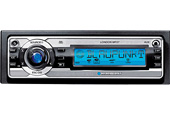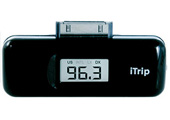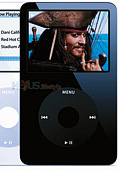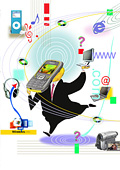|
It's
the plateau and you're at risk of hitting it two or three years
after you've begun hitting the gym. Let's say you have been passably
regular about your workouts (three or four times a week, most
weeks). You're eating healthy too and not bingeing on alcohol.
Yet, you don't seem to see any further changes to your body. Your
muscle strength or size isn't changing appreciably and going to
the gym is becoming a bit of a chore. I don't have the stats on
this but this is probably when most people tend to give up on
workouts, dropping out of gyms or just losing interest.
Yet there are ways of busting the dreaded plateau. Like many
of us, muscles also grow tired of doing the same thing over and
over again. So, doing the same exercises week after week makes
muscles immune to their benefits. One way out of a plateau or
rut is to change your routine once every three weeks.
Say, you're doing four days of workouts every week: Day One:
Chest plus Triceps; Day Two: Back plus Biceps; Day Three: Shoulders
plus Quads; Day Four: Calves plus Forearms and Abs. Typically,
on the first day, you could be doing your chest exercises followed
by triceps workouts. On the second day, exercises for the back
followed by biceps and so on. If you stick to such a format over
a prolonged period, your muscles get used to the workout. One
suggestion: mix them up.
In the spirit of eating one's own dog food, let me describe
my plateau buster: Giant Sets. Instead of one type of exercise
at a time (say, three sets of bench presses), I'm doing a set
that comprises three sub-sets of exercises targeting three different
muscle groups. That is, on Day One, I target my chest, back and
biceps. And instead of sets of exercises aimed at individual muscle
groups, I do one mega set, targeting all three. Here's an example:
a set comprising 12 repetitions of bench presses (targeting the
chest), 12 repetitions of seated rows (targeting the back) and
12 repetitions of biceps curls. The three exercises have to be
done seamlessly and without resting. That completes one giant
set. Rest and repeat. Like that I do two more giant sets each
comprising a different combination of exercises targeting the
three muscle groups for the day-chest, back and biceps-repeating
each set once (that is, doing each of them twice). On Day Two,
I do giant sets to target shoulders, triceps and hamstring muscles;
on Day Three, quads, deltoids & traps and forearms.
Exercise of the fortnight: Beginning this installment, Treadmill
shall feature an exercise of the fortnight. Today's is the walking
lunge (see illust.) for the quads. Grasp dumb-bells at your sides.
Step forward with one leg; land on your heel and then forefoot.
Lower your body by bending at the knee and hip of the first leg.
Push to stand on the leg that extends in front and lunge forward
with the other leg. Repeat. Keep your back straight and head up.
-Muscles
Mani
write to musclesmani@intoday.com
Caveat: The physical exercises
described in Treadmill are not recommendations. Readers should
exercise caution and consult a physician before attempting to
follow any of these.
BACK IN SHAPE
If you
are ignoring sporadic back pains, and don't know whom to turn
to for advice, then read on. Here are five ways to maintain a
healthy back.
Ride Right. Your back need not pay the price for the
long distances you have to travel every day. While driving, ensure
that your seat is properly adjusted to reduce stress on your back.
Says Dr Harsh Bhargava, Senior Consultant, Indraprastha Apollo
Hospital, New Delhi: "Adjust your seat to the position you
are most comfortable in-you should be able to lean back on your
seat and comfortably grasp the steering wheel. If you have an
adjustable lumbar support, adjust it to where you have a slight
inward curve into your low back."
Sit Smart: Says Dr K.B. Attri, Senior Consultant, Indraprastha
Apollo Hospital: "At work, make sure that your monitor is
set directly in front of your chest so that you do not have to
turn your head or twist your back. The top of the monitor should
be at eye level." Never cradle a phone between your neck
and shoulder. Use hands-free devices, instead.
Feed Your Spine. Eat a healthy diet of fresh fruits and
vegetables. Don't drown food in sauces, butter and dressings.
Limit soft drinks, candy bars, ice-cream, cookies, and other sweets.
Says Dr Bhargava: "Remember to get enough calcium (found
in dairy products) and vitamin D to keep your bones resilient."
Bed Basics. Says Dr Attri: "Sleeping on a soft bed
can strain your back muscles since the curves of the spine are
not adequately supported. Sleeping on your stomach is not recommended
as it can cause strain on the back. Make sure you have a firm
mattress that keeps the spine aligned and supports the spinal
curvatures."
Road to Recovery. Take up aerobics or yoga, under expert
guidance. Says Dr Attri: "Yoga can also help by healing injured
back muscles."
-Manu Kaushik
DRIVE
Get Your Car iPod-ready
There are many ways to play back Apple's iconic music player in
your car.
 Given
the tendency of manufacturers to add an "i" before a
product, it is surprising that there isn't an iCar yet. But, if
you own an iPod, at least a post-2005 model, there are ways you
can play it back on your car. All you need is the correct accessory
or music system. Given
the tendency of manufacturers to add an "i" before a
product, it is surprising that there isn't an iCar yet. But, if
you own an iPod, at least a post-2005 model, there are ways you
can play it back on your car. All you need is the correct accessory
or music system.
In the West, most mainstream cars come with an iPod connection
along with the stereo. In India, several manufacturers-including
Alpine, Blaupunkt and Pioneer-sell head units that are compatible
with iPods; all they need is a special interface cable and dock
that you need to purchase. This interface cable, however, isn't
the easiest accessory to come by. Systems like the Blaupunkt Mumbai
mp26, which costs Rs 7,500, is a multi-format digital audio CD-player
and is the cheapest iPod-ready system out there. Blaupunkt's iPod
interface cable is available at select Blaupunkt resellers for
Rs 5,700. Blaupunkt also has a Bluetooth accessory that allows
you to not only answer your phone but also stream music from a
Bluetooth-capable device such as your laptop or your mobile to
your car stereo.
 The
second way to play your iPod back on your car is one of the simplest.
Some car systems come with a 3.5mm stereo connection that plays
back sound through the auxiliary mode. The problem is that there
are not too many in-car audio systems that come with this point
anymore. In case your car has such a connection, all you need
to get is a 3.5mm-to-3.5mm lead and connect your iPod's headphone
jack to your car stereo. However, it will not charge your iPod. The
second way to play your iPod back on your car is one of the simplest.
Some car systems come with a 3.5mm stereo connection that plays
back sound through the auxiliary mode. The problem is that there
are not too many in-car audio systems that come with this point
anymore. In case your car has such a connection, all you need
to get is a 3.5mm-to-3.5mm lead and connect your iPod's headphone
jack to your car stereo. However, it will not charge your iPod.
The third way to play back your iPod in your car is through
the iPod-to-cassette accessory. Belkin makes one and it costs
around Rs 1,000-1,200 depending on where you buy it. This connects
to your iPod headphone jack and plays back the music through a
cassette. However, there is a deterioration in playback quality,
and given that most in-car systems do not come with a cassette
player, this option is quickly going the way of the dinosaur.
 The
fourth way to play back your iPod on your car is by using a radio
adapter such as the Griffin iTrip or Belkin's TuneCast and TuneDok
systems. The Griffin iTrip, which is quite popular, now comes
with a digital lcd display and allows you to not only select the
frequency band you want to transmit your music on, but also the
quality of the signal. Higher quality signals are essential for
cities with several radio stations because there is a significant
amount of background noise. Many Apple resellers in India do not
store the iTrip currently, but you can get one for around Rs 2,500-3,000,
or buy one abroad for $50 (Rs 2,050). The
fourth way to play back your iPod on your car is by using a radio
adapter such as the Griffin iTrip or Belkin's TuneCast and TuneDok
systems. The Griffin iTrip, which is quite popular, now comes
with a digital lcd display and allows you to not only select the
frequency band you want to transmit your music on, but also the
quality of the signal. Higher quality signals are essential for
cities with several radio stations because there is a significant
amount of background noise. Many Apple resellers in India do not
store the iTrip currently, but you can get one for around Rs 2,500-3,000,
or buy one abroad for $50 (Rs 2,050).
Belkin's Tunecast is a small fm transmitter that plugs into
your iPod's headphone jack and works with any audio device with
a regular headphone jack. Audio quality is ordinary, but the product
is not device-specific. The TuneDok, on the other hand, is iPod-specific
and comes with a hard plastic stand which plugs into a vehicle's
9v connector--the cigarette lighter connection-so that it can
also charge your iPod while transmitting. The hard stand, however,
is flexible enough to ensure that your iPod doesn't rattle around
too much. These systems cost around Rs 2,000-2,500 each, again
depending on whether you buy them legally or from the grey market.
So, your iPod isn't a device that becomes useless in your car,
and with close to 80GB of music in the top model, why should you
carry hundreds of CDs? But whatever you do, remember, never plug
in your headphones while driving; it is dangerous.
-Kushan Mitra
PRINTED
CIRCUIT
Technology Overload
Is too much tech hurting devices?
The handy old Nokia 3310 and 5110
were great devices-they did the job they had to, that is, making
calls, quite well. The batteries lasted a few days without a recharge
and everybody used one. Even when people started text messaging,
the batteries didn't suddenly go on the blink because too many
applications were being supported.
Look at the average cell phone today. All manufacturers are
trying to cram in more and more features onto a device smaller
than your palm. The latest devices have Global Positioning Satellite
receivers, and, according to reports, by next year, will even
feature 5-megapixel cameras as standard with top-end devices that
will also have six-to-seven radio transceivers, 10-gigabytes of
on-board memory and what not. There we go again, with tech, specs
and more... But sometimes, even the geek inside you wonders: "Do
phones-and, indeed, all other electronic gadgets-really need so
much tech?"
The answer to that, paradoxically, is both yes and no. James
Surowiecki says in a recent article in The New Yorker that consumers
expect to be bombarded with new and sophisticated features on
gadgets every few months. This is, ironically, where the paradox
kicks in. The very features that attract consumers in the first
place could also be the ones that put them off for being too complicated.
This "feature creep", as Surowiecki calls it, is also
due, in part, to another phenomenon called "internal audience
problem". Products are invariably conceptualised by engineers,
designers and marketers who feel that adding ever newer features
adds value to these gizmos. And given that it doesn't really cost
an arm and a leg to load any number of new features onto a gadget,
it is not difficult to understand why manufacturers are doing
so. But the truth is that the average user-who may be impressed
with that romantic ad about how you can be deep in the Amazon
forest and still save the planet from sheer doom using that handy
501-in-1 device-still may not want such a device. Most people
want reliable and sturdy devices, and for readers of this magazine
at least, decent looking ones, which get the job done.
A consumer study done in the US recently, and quoted in the
same The New Yorker article, says most consumers will, at first
choose a features-rich product, but, after a few (usually unsuccessful)
attempts at mastering them, settle for a simpler one. The moral
of the story: the features that most people find sexy, unfortunately,
aren't always the ones they're comfortable living with. This column
loves feature-rich products, but then, we are not the average
user, and therein lies the problem. Most people don't use more
than half the features available on their phones, computers, TVS
and cameras. For example, how many lay consumers actually use
multi-media on their phones. So is it pointless buying a phone
like the Nokia N95? Not really. The geeks will love it; and the
non-geeks will flaunt it to impress friends, colleagues and partners.
The recently-launched Nokia 6300 is a simple product; that's
why this column liked the handset so much. Did you use the last
version of Microsoft Office? MS Word was like a minefield of options.
And honestly, for many people, no, make that to most people, such
tremendous levels of complexity can be quite a put-off. Why, for
example, has Office 2007 received such great reviews? Simply because
it is the first version of that software in almost a decade that
puts the average user back in the driving seat. It is simple.
That is why the iPod has been so successful. Not only did it make
a fashion statement but even the most tech un-savvy person could
use it.
So, here is a plea to technology hardware and software manufacturers-don't
forget your users.
-Kushan Mitra
|





 Given
the tendency of manufacturers to add an "i" before a
product, it is surprising that there isn't an iCar yet. But, if
you own an iPod, at least a post-2005 model, there are ways you
can play it back on your car. All you need is the correct accessory
or music system.
Given
the tendency of manufacturers to add an "i" before a
product, it is surprising that there isn't an iCar yet. But, if
you own an iPod, at least a post-2005 model, there are ways you
can play it back on your car. All you need is the correct accessory
or music system. The
second way to play your iPod back on your car is one of the simplest.
Some car systems come with a 3.5mm stereo connection that plays
back sound through the auxiliary mode. The problem is that there
are not too many in-car audio systems that come with this point
anymore. In case your car has such a connection, all you need
to get is a 3.5mm-to-3.5mm lead and connect your iPod's headphone
jack to your car stereo. However, it will not charge your iPod.
The
second way to play your iPod back on your car is one of the simplest.
Some car systems come with a 3.5mm stereo connection that plays
back sound through the auxiliary mode. The problem is that there
are not too many in-car audio systems that come with this point
anymore. In case your car has such a connection, all you need
to get is a 3.5mm-to-3.5mm lead and connect your iPod's headphone
jack to your car stereo. However, it will not charge your iPod.
 The
fourth way to play back your iPod on your car is by using a radio
adapter such as the Griffin iTrip or Belkin's TuneCast and TuneDok
systems. The Griffin iTrip, which is quite popular, now comes
with a digital lcd display and allows you to not only select the
frequency band you want to transmit your music on, but also the
quality of the signal. Higher quality signals are essential for
cities with several radio stations because there is a significant
amount of background noise. Many Apple resellers in India do not
store the iTrip currently, but you can get one for around Rs 2,500-3,000,
or buy one abroad for $50 (Rs 2,050).
The
fourth way to play back your iPod on your car is by using a radio
adapter such as the Griffin iTrip or Belkin's TuneCast and TuneDok
systems. The Griffin iTrip, which is quite popular, now comes
with a digital lcd display and allows you to not only select the
frequency band you want to transmit your music on, but also the
quality of the signal. Higher quality signals are essential for
cities with several radio stations because there is a significant
amount of background noise. Many Apple resellers in India do not
store the iTrip currently, but you can get one for around Rs 2,500-3,000,
or buy one abroad for $50 (Rs 2,050). 